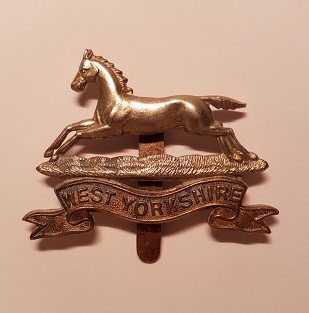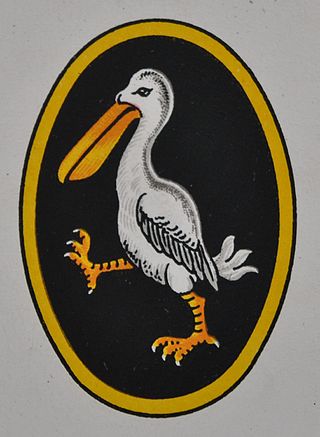Related Research Articles

The South Staffordshire Regiment was a line infantry regiment of the British Army in existence for only 68 years. The regiment was created in 1881 under the Childers Reforms by the amalgamation of the 38th Regiment of Foot and the 80th Regiment of Foot. The regiment saw service in the Second Boer War, World War I and World War II.

The 49th Infantry Division was an infantry division of the British Army. The division fought in the First World War in the trenches of the Western Front, in the fields of France and Flanders. During the Second World War, the division fought in the Norwegian Campaign and in North-western Europe. After the Second World War, it was disbanded in 1946, then reformed in 1947. It remained with Northern Command until finally disbanded in 1967.

The Essex Regiment was a line infantry regiment of the British Army in existence from 1881 to 1958. The regiment served in many conflicts such as the Second Boer War and both World War I and World War II, serving with distinction in all three. It was formed in 1881 under the Childers Reforms by the amalgamation of the 44th Regiment of Foot and the 56th Regiment of Foot.

The West Yorkshire Regiment (Prince of Wales's Own) (14th Foot) was an infantry regiment of the British Army. In 1958 it amalgamated with the East Yorkshire Regiment (15th Foot) to form the Prince of Wales's Own Regiment of Yorkshire which was, on 6 June 2006, amalgamated with the Green Howards and the Duke of Wellington's Regiment (West Riding) to form the Yorkshire Regiment (14th/15th, 19th and 33rd/76th Foot).

The South Lancashire Regiment was a line infantry regiment of the British Army in existence from 1881 to 1958.

The Dorset Regiment was a line infantry regiment of the British Army in existence from 1881 to 1958, being the county regiment of Dorset. Until 1951, it was formally called the Dorsetshire Regiment, although usually known as "The Dorsets". In 1958, after service in the Second Boer War along with World War I and World War II, the Dorset Regiment was amalgamated with the Devonshire Regiment to form the Devonshire and Dorset Regiment. In 2007, it was amalgamated with the Royal Gloucestershire, Berkshire and Wiltshire Regiment, The Light Infantry and the Royal Green Jackets to form a new large regiment, The Rifles.

The York and Lancaster Regiment was a line infantry regiment of the British Army that existed from 1881 until 1968. The regiment was created in the Childers Reforms of 1881 by the amalgamation of the 65th Regiment of Foot and the 84th Regiment of Foot. The regiment saw service in many small conflicts and both World War I and World War II until 1968, when the regiment chose to be disbanded rather than amalgamated with another regiment, one of only two infantry regiments in the British Army to do so, with the other being the Cameronians.

The King's Own Yorkshire Light Infantry (KOYLI) was a light infantry regiment of the British Army. It officially existed from 1881 to 1968, but its predecessors go back to 1755. In 1968, the regiment was amalgamated with the Somerset and Cornwall Light Infantry, the King's Shropshire Light Infantry and the Durham Light Infantry to form The Light Infantry, which in turn was merged with the Devonshire and Dorset Regiment, the Royal Gloucestershire, Berkshire and Wiltshire Regiment and the Royal Green Jackets to become The Rifles in 2007.

The West Riding Artillery was formed as a group of volunteer units of the British Army in 1860. Its units later formed the divisional artillery of the West Riding Division of the Territorial Force in World War I and World War II. The West Riding Artillery's lineage is continued in a battery of today's Army Reserve
The Hallamshire Battalion was an infantry battalion of the York and Lancaster Regiment, part of the British Army in existence from 1859.

The Sherwood Foresters was a line infantry regiment of the British Army in existence for just under 90 years, from 1881 to 1970. In 1970, the regiment was amalgamated with the Worcestershire Regiment to form the Worcestershire and Sherwood Foresters Regiment, which in 2007 was amalgamated with the Cheshire Regiment and the Staffordshire Regiment to form the present Mercian Regiment. The lineage of the Sherwood Foresters is now continued by The Mercian Regiment.

The 146th Infantry Brigade was an infantry brigade formation of the British Army, part of the Territorial Force with the 49th Infantry Division. The brigade saw active service during both the First and the Second World Wars, and during the early part of the Cold War. The brigade was active from 1908 until 1967 when it was finally disbanded. The brigade was reformed in 1983, though with a much smaller and insignificant role before finally disbanding again in 1993.

The 147th Infantry Brigade was an infantry brigade of the British Army, part of the Territorial Force, that served in both the First and the Second World Wars with the 49th Infantry Division.

This is the order of battle for the ground campaign in the Gulf War between U.S. and Coalition Forces and the Iraqi Armed Forces between February 24–28, 1991. The order that they are listed in are from west to east. Iraqi units that were not in the Kuwaiti Theater of Operations are excluded from this list. Some Iraqi divisions remained un-identified by Department of Defense intelligence and a number of the details of the Iraqi order of battle are in dispute among various authoritative sources.

The 62nd Division was an infantry division of the British Army that saw active service on the Western Front during the First World War.
The 222nd Infantry Brigade was a Home Service formation of the British Army that existed under various short-lived titles in both the First and Second World Wars
The 138th Brigade was an infantry brigade of the British Army that saw active service in the First World War with the 46th Division. The brigade again saw active service in the Second World War, with the 46th Infantry Division.

The 148th Infantry Brigade was an infantry brigade formation of the British Army that served in both the First and briefly in the Second World War as part of the 49th Infantry Division and disbanded after the war.
The 139th Brigade was an infantry brigade of the British Army that saw active service in the First World War with the 46th Division. Later designated the 139th Infantry Brigade, the brigade also saw service with the 46th Infantry Division in the Second World War.
References
- J.B.M. Frederick, Lineage Book of British Land Forces 1660–1978, Vol I, Wakefield: Microform Academic, 1984, ISBN 1-85117-007-3.
- Brig E.A. James, British Regiments 1914–18, London: Samson Books, 1978, ISBN 0-906304-03-2/Uckfield: Naval & Military Press, 2001, ISBN 978-1-84342-197-9.
- Norman E.H. Litchfield, The Territorial Artillery 1908–1988 (Their Lineage, Uniforms and Badges), Nottingham: Sherwood Press, 1992, ISBN 0-9508205-2-0.